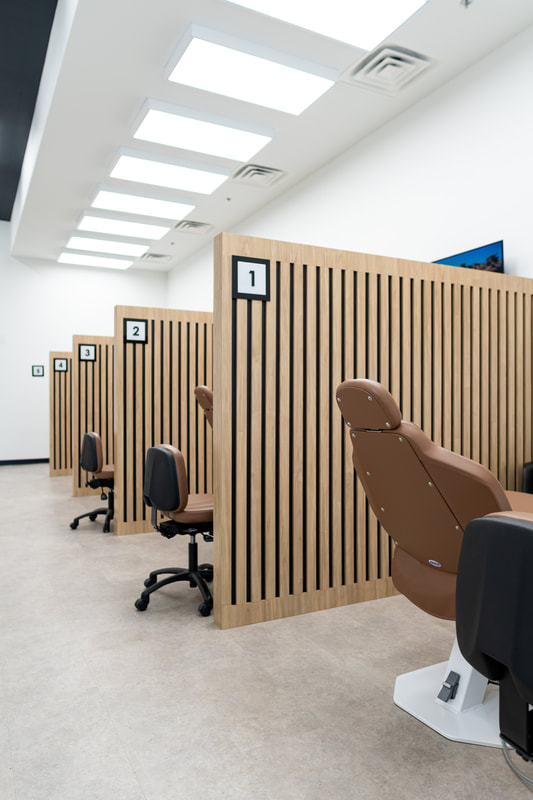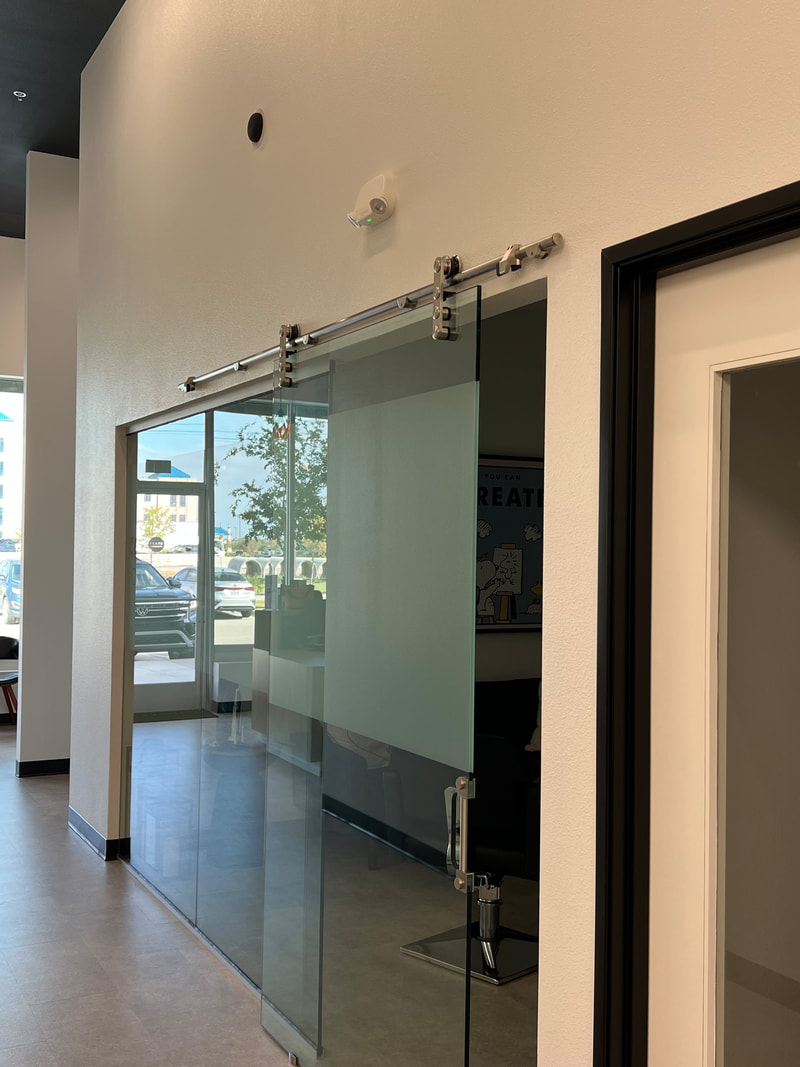|
The design of an orthodontic office is not just about aesthetics; it plays a crucial role in patient comfort, staff efficiency, and overall productivity. In this blog post, we'll explore the key considerations for designing the perfect floor plan for an orthodontic office.
1. Reception Area The reception area is the first point of contact for patients, and it sets the tone for their experience. It should be welcoming and comfortable. Consider these elements: - A spacious and well-lit area with comfortable seating for patients and their companions. - A welcoming front desk with a friendly receptionist to greet patients. - Educational materials and visuals to inform patients about orthodontic treatments. - A designated kids' corner with toys and books to keep young patients entertained. In addition to these elements, it's crucial to size the reception area in a way that matches the anticipated patient volume and the number of treatment chairs in your office. For instance, if you plan to see 80-100 patients a day, ensure the reception area can efficiently accommodate this volume without overcrowding. 2. Treatment Rooms Treatment rooms are the heart of the orthodontic office. They should be designed for efficiency and patient comfort: - Open Bay Treatment Rooms: Traditionally, open bay treatment rooms are designed with multiple chairs in one large space. This layout encourages a communal and social atmosphere and can be more cost-effective. However, post-COVID, some patients may prefer a higher level of privacy. - Open Bay Treatment Rooms with Privacy Walls: In response to changing patient preferences and the need for enhanced privacy in the post-COVID era, many orthodontic offices are adopting open bay treatment rooms with privacy walls. These walls can be either partial or full height and provide a level of separation and privacy for patients. They still allow for a sense of community but offer a compromise between the traditional open bay and fully enclosed treatment rooms. You can look at our privacy walls at Elate Orthodontics by clicking here. When discussing the floor plan for your orthodontic office, consider the patient experience and their comfort level in the treatment rooms. The choice between open bay and open bay with privacy walls should align with your practice's philosophy and the preferences of your patient demographic. 3. Sterilization Area: Optimizing Instrument Workflow The sterilization area in your orthodontic office is a critical component of infection control and patient safety. Ensuring an efficient flow of instruments from the point they are used to when they are ready for reuse is vital. Here's how you can optimize this workflow: Dirty to Clean Instrument Flow: 1. Dirty Instruments In: Begin with a designated area where used instruments are collected. 2. Washing and Cleaning: Once collected, the dirty instruments should be taken to the washing area. Here, they are thoroughly cleaned and prepped for sterilization. Ultrasonic cleaners, and other cleaning equipment should be readily available and properly sequenced. 3. Drying: After cleaning, the instruments should be thoroughly dried to prevent any remaining moisture, which can impact the sterilization process. You should have dedicated drying racks or stations to ensure this step is done correctly. 4. Bagging: Clean, dry instruments should be carefully bagged or packaged in sterilization pouches. These pouches should be clearly labeled with the date of sterilization to ensure proper tracking and adherence to infection control standards. 5. Sterilization: The next step is the actual sterilization of the instruments. This is typically done using autoclaves, our favorite is M-11 Midmark. It's crucial to monitor the autoclave's performance regularly and maintain proper sterilization records. 6. Moving to the Clean Area: Once sterilized, the instruments should be carefully transported to the clean area. This area should be kept separate from the dirty area to prevent cross-contamination. Implement a clear system for organizing and storing sterilized instruments until they are needed. An efficient instrument workflow in your sterilization area not only ensures patient safety but also allows your orthodontic practice to run smoothly. Patients can be confident in the cleanliness and safety of the instruments used in their treatments, and your staff can work more efficiently with well-organized and optimized processes. 4. Consultation Room: Enhancing the Patient Experience and Flow A dedicated consultation room in your orthodontic office is a vital space for discussing treatment plans and making crucial decisions with your patients and their families. To optimize the patient experience and maintain a smooth flow of new patient exams, consider the following: Strategic Placement: - Proximity to Waiting Area: Locate the consultation room close to the reception area and waiting room. This ensures that patients and their families can easily transition from the initial check-in to the consultation, maintaining a smooth flow of new patient exams. - Near the X-ray Room: Placing the consultation room in proximity to the X-ray and imaging room is highly advantageous. This strategic placement allows for quick access to X-ray images and facilitates a seamless transition from diagnostic imaging to consultation. By strategically placing the consultation room, using technology to display X-rays and scans, and creating a comfortable and private space for discussions, you can provide a more comprehensive and patient-centered approach to orthodontic consultations. This not only ensures that patients and their families have a clear understanding of their treatment options but also helps maintain a smooth flow of new patient exams in your orthodontic office. 5. X-ray and Imaging Room: Ensuring Compatibility Orthodontic treatment often relies on diagnostic imaging to make informed decisions and track progress. To ensure that your X-ray and imaging room is well-equipped and properly designed, consider the following: Machine Compatibility: - Know Your X-ray Machine: Before planning the X-ray room, it's essential to have a clear understanding of the specific X-ray machine you are purchasing. Different X-ray machines have varying space and power requirements, and their dimensions can significantly impact the room design. - Room Dimensions: The dimensions of your X-ray machine should align with the dimensions of the X-ray room. Ensure that the room can comfortably accommodate the machine while leaving space for the technician to operate it and for patients to be positioned appropriately. - Lead-Lined Walls: depending on state regulations, X-ray rooms may have lead-lined walls to protect patients, staff, and the surrounding areas from radiation exposure. Confirm that the lead-lined walls are in line with the safety standards for the X-ray machine you plan to use. - Power Requirements: Different X-ray machines have varying power requirements. Ensure that the electrical supply in the X-ray room meets the specifications of your chosen machine. This includes voltage, current, and the need for any additional power outlets. - Technician Workspace: Design the X-ray room to provide ample space for the technician to work comfortably and safely. Adequate space ensures that positioning patients for X-ray scans is efficient and accurate. 6. Staff Area: Balancing Size and Amenities - Appropriate Size: While it's essential to provide a comfortable space for your staff, avoid making the staff room too large. Most staff members often leave the office during lunchtime to eat, so a moderate-sized staff area is often sufficient. - Washer and Dryer Hookup: Consider adding a washer and dryer hookup to the staff area. This can be convenient for staff who may need to launder their uniforms or other items during the workday. - Break room with seating, kitchenette, and storage for personal items. 7. Mechanical room One key consideration for the mechanical room is its placement. Ideally, it should be located as far back as possible within the office space. Placing the mechanical room away from patient treatment and consultation areas is essential to minimize noise disturbance. The hum of suction and compressor systems and the operation of other mechanical equipment should be virtually imperceptible in the clinical and consultation areas, creating a tranquil atmosphere that enhances the patient experience. Careful planning in the placement of the mechanical room ensures that the critical functions it performs do not interfere with the serenity of your orthodontic practice. 8. Accessibility (ADA compliance) Ensure that the office is accessible to all patients, including those with mobility challenges. Install ramps and make sure doorways are wide enough to accommodate wheelchairs and other mobility aids. 9. Aesthetics and Branding The aesthetics of the office should reflect your practice's brand and create a pleasant atmosphere. Consider elements like color schemes, artwork, and decor that align with your orthodontic office's image. 10. Future Growth Plan your floor layout with potential growth in mind. If your practice is likely to expand, leave space for additional treatment rooms, staff, and equipment. Conclusion Designing the ideal floor plan for an orthodontic office is a thoughtful process that combines functionality, aesthetics, and patient comfort. A well-designed office not only enhances the patient experience but also improves staff efficiency and overall productivity. By carefully considering the elements mentioned above and sizing the reception area to match your patient volume, incorporating open bay treatment rooms with privacy walls, optimizing the workflow in the sterilization area, placing the consultation room strategically, ensuring X-ray machine compatibility, and enhancing the overall patient experience, you can create an orthodontic office that stands out in terms of both form and function, ultimately contributing to the success of your practice. Moreover, don't hesitate to reach out to dental contractors or professional design firms like Joe Architect or Kappler Design for expert guidance and assistance in creating the perfect orthodontic office layout. Starting an orthodontic practice is an exciting endeavor, but creating the right ambiance in your office is crucial to providing your patients with a positive experience. One way to enhance the atmosphere is by using the Google Nest Mini for office music. In this blog post, we'll explore how you can use Google Nest Mini to set the right tone in your orthodontic start-up office while enjoying the low cost and the ability to control the sound in each room separately.
Advantages of Google Nest Mini The Google Nest Mini is a compact and budget-friendly smart speaker that's perfect for your orthodontic start-up office. Here are some key advantages: 1. Low Cost: The Google Nest Mini is an cost effective sound system for orthodontic startup office, making it an ideal choice for start-up offices looking to manage costs while providing a comfortable environment for their patients. 2. Room-to-Room Control: One of the standout features of Google Nest Mini is the ability to control the sound in each room separately. This means you can tailor the music experience to different areas of your office without investing in expensive audio systems. Setting Up Google Nest Mini Getting your Google Nest Mini up and running in your orthodontic office is easy. Here's how to set it up: 1. Purchase Your Google Nest Mini: You can find Google Nest Mini online or at various retail stores. The device is compact and blends seamlessly with your office decor. 2. Download the Google Home App: To set up and control your Google Nest Mini, download the Google Home app on your smartphone or tablet. 3. Connect to Wi-Fi: Follow the on-screen instructions in the app to connect your Google Nest Mini to your office Wi-Fi network. Creating a Room-by-Room Music Experience One of the most significant advantages of the Google Nest Mini is its ability to control the sound in each room separately. Here's how to create a customized music experience for your orthodontic office: 1. Name Your Rooms: Within the Google Home app, you can name each Google Nest Mini based on the room it's placed in, such as "Waiting Room," "Treatment Room 1," and so on. 2. Custom Playlists: Create playlists or choose from a wide range of music genres available through music streaming services like Spotify or Google Play Music. 3. Control Volume Independently: Use the app to control the volume for each room separately. This allows you to adjust the music to suit the unique atmosphere you want to create. Enhancing the Patient Experience With Google Nest Mini, you can create an inviting and calming atmosphere for your patients: - In the waiting room, play soothing and calming music to help patients relax and feel at ease. - In the treatment rooms, choose more neutral, instrumental tracks to provide a comfortable background for patients during their appointments. - Tailor the volume in each area to ensure the music is at an appropriate level without disturbing other patients. Conclusion The Google Nest Mini is a cost-effective solution for your orthodontic start-up office. Its room-by-room sound control feature makes it easy to provide a tailored and comfortable atmosphere for your patients. By setting up Google Nest Mini and curating your office music, you can create a positive and memorable impression while keeping costs in check. Elevate your orthodontic practice with the Google Nest Mini, making your office a welcoming and harmonious space for your patients. For young orthodontists and orthodontic residents, the question of practice ownership looms large on the horizon. As you embark on your career in orthodontics, you're faced with crucial decisions that will shape your professional path. One of the most significant questions you'll grapple with is whether practice ownership is worth it. In this blog post, we'll explore the pros and cons of owning your own orthodontic practice to help you make an informed decision.
Pros of Practice Ownership 1. Independence and Autonomy: Owning your practice allows you to set your own rules and practice orthodontics the way you envision it. You have the autonomy to make clinical decisions and shape the patient experience. 2. Financial Potential: Practice ownership can be financially rewarding in the long run. You have the opportunity to build equity and generate higher income compared to being an associate. 3. Building a Legacy: Owning a practice gives you the chance to build a legacy and leave a lasting impact on your community. You can establish a trusted brand and serve patients for generations. 4. Career Fulfillment: Many orthodontists find immense satisfaction in building and growing their own practices. The sense of accomplishment and pride can be personally fulfilling. Cons of Practice Ownership 1. Financial Risk: Starting and running a practice comes with significant financial risks. You'll need to secure financing, manage overhead costs, and navigate the uncertainties of the business world. 2. Time and Effort: Owning a practice demands a substantial time commitment. You'll be responsible for both clinical work and managing the business, which can be overwhelming. 3. Administrative Responsibilities: Practice owners must handle administrative tasks, including hiring and managing staff, marketing, and dealing with insurance and regulatory matters. 4. Market Saturation: In some areas, the market may already be saturated with orthodontic practices, making it challenging to establish a new practice. Considerations for Young Orthodontists and Residents 1. Experience: Consider gaining experience as an associate before diving into practice ownership. This can help you refine your clinical skills and learn about the business side of orthodontics. 2. Business Education: Invest in learning about business management and entrepreneurship. Courses or workshops in these areas can prepare you for the challenges of running a practice. 3. Financial Preparedness: Ensure you have a solid financial plan in place, including securing funding, managing debt, and creating a budget for your practice. 4. Market Analysis: Conduct thorough market research to identify potential locations for your practice and assess the level of competition. 5. Mentorship: Seek guidance and mentorship from experienced practice owners who can offer insights and advice. Conclusion Practice ownership is a significant decision that can shape the trajectory of your orthodontic career. It offers independence, financial potential, and the opportunity to leave a lasting legacy. However, it also comes with risks, responsibilities, and demands on your time and resources. Young orthodontists and residents should carefully weigh the pros and cons, gain experience, and seek mentorship to make an informed choice. Ultimately, whether practice ownership is worth it depends on your personal goals, aspirations, and willingness to embrace the challenges of entrepreneurship in the world of orthodontics. Setting up an orthodontic office is an exciting venture with lots of ups and downs. However, one of the critical decisions you'll need to make is finding the ideal location for your practice. Choosing the right location can greatly influence your success and patient flow. In this blog post, we'll walk you through the essential steps to find the perfect location for your orthodontic office.
1. Conduct Market Research Before you start scouting for locations, it's crucial to conduct thorough market research. Understand the demographics of your target patient population. Consider factors such as age, income, and dental insurance coverage. This information will help you identify areas with a higher demand for orthodontic services. 2. Analyze Competitor Presence Study your competition. Identify other orthodontic practices in the area and evaluate their services, reputation, and patient base. A location with fewer competitors or opportunities for differentiation may be more favorable. 3. Evaluate Accessibility Accessibility is a critical factor in choosing your office location. Consider the proximity to major roads, highways, and public transportation. Ensure that the location is easy to find and has ample parking space for your patients. 4. Assess Nearby Schools and Businesses Orthodontic patients often include children and teenagers. Being close to schools and educational institutions can increase your visibility and patient base. Additionally, proximity to other businesses, such as general or pediatric dentists, can lead to referrals. 5. Check Zoning Regulations Check local zoning regulations and building codes to ensure that your chosen location is suitable for a dental practice. Some areas may have restrictions or requirements for healthcare facilities. Some retail spaces may have exclusivity in place for orthodontics. 6. Consider the Size and Layout Evaluate the size and layout of potential office spaces. Ensure that there is enough space for treatment rooms, waiting areas, and administrative work. A well-designed office can enhance patient experience and staff efficiency. 7. Negotiate Lease Terms Once you've identified a promising location, you would need a real estate attorney to negotiate lease terms with the property owner or landlord. Pay attention to factors like lease duration, rent costs, and any potential incentives for tenant improvements. 8. Factor in Visibility and Signage Visibility is key for attracting new patients. Choose a location with good visibility from the street and consider investing in professional signage to make your practice easily recognizable. 9. Assess Security and Safety Ensure the safety and security of both your staff and patients. Research crime rates in the area and consider installing security systems and protocols to protect your practice. 10. Plan for Growth Think long-term. As your orthodontic practice grows, will the chosen location accommodate your expansion plans? Avoid getting locked into a lease that may limit your practice's future growth. Conclusion Selecting the perfect location for your orthodontic office is a critical decision that can significantly impact the success of your practice. By conducting thorough research, considering accessibility, evaluating nearby schools and businesses, and ensuring compliance with zoning regulations, you can make an informed decision. Remember that the right location not only helps you attract patients but also enhances your practice's overall reputation and success. Take your time, weigh your options carefully, and remember your office location is probably the most consequential decision in your practice ownership journey. |
AuthorDr. Kevin Baharvand Archives
February 2024
Categories |
|
The Most Comprehensive Orthodontic Office Startup Consulting and Support. Our goal is very simple: to help you independently run every aspect of your practice.
Be sure to join our exclusive White Glove Orthodontist - The Cohort Facebook group here:
www.facebook.com/groups/1422176485029479/ |





 RSS Feed
RSS Feed
